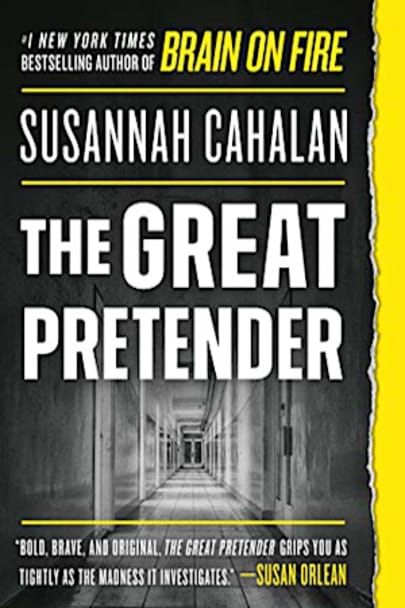Shortlisted for the 2020 Royal Society Insight Investment Science Book Prize Named a Best Book of 2020 by The Guardian * The Telegraph * The Times “One of America’s most courageous young journalists” and the author of the #1 New York Times bestselling memoir Brain on Fire investigates the shocking mystery behind the dramatic experiment that revolutionized modern medicine (NPR). Doctors … dramatic experiment that revolutionized modern medicine (NPR).
Doctors have struggled for centuries to define insanity–how do you diagnose it, how do you treat it, how do you even know what it is? In search of an answer, in the 1970s a Stanford psychologist named David Rosenhan and seven other people–sane, healthy, well-adjusted members of society–went undercover into asylums around America to test the legitimacy of psychiatry’s labels. Forced to remain inside until they’d “proven” themselves sane, all eight emerged with alarming diagnoses and even more troubling stories of their treatment. Rosenhan’s watershed study broke open the field of psychiatry, closing down institutions and changing mental health diagnosis forever.
But, as Cahalan’s explosive new research shows in this real-life detective story, very little in this saga is exactly as it seems. What really happened behind those closed asylum doors?
ses and even more troubling stories of their treatment. Rosenhan’s watershed study broke open the field of psychiatry, closing down institutions and changing mental health diagnosis forever.
But, as Cahalan’s explosive new research shows in this real-life detective story, very little in this saga is exactly as it seems. What really happened behind those closed asylum doors?ses and even more troubling stories of their treatment. Rosenhan’s watershed study broke open the field of psychiatry, closing down institutions and changing mental health diagnosis forever.
But, as Cahalan’s explosive new research shows in this real-life detective story, very little in this saga is exactly as it seems. What really happened behind those closed asylum doors?ses and even more troubling stories of their treatment. Rosenhan’s watershed study broke open the field of psychiatry, closing down institutions and changing mental health diagnosis forever.
But, as Cahalan’s explosive new research shows in this real-life detective story, very little in this saga is exactly as it seems. What really happened behind those closed asylum doors?more



After being diagnosed with a rare autoimmune disease of the brain by Dr.Souhil Najjar,Susannah Cahalan shares her experience of almost having her condition missed and condemned to a mental institution as many individuals with mental illness now live . The author quotes Daniel Boorstein who states The greatest obstacle to discovery is not ignorance it is the illustion of knowledge .The writer leads us to the importance of research,second opinions and refusal to give up on our loved ones when mental illness strikes.
Susannah Calahan is the author of the bestselling memoir Brain on Fire: My Month of Madness, in which she describes an amazing ordeal in which she was misdiagnosed with a mental illness that was actually autoimmune encephalitis that caused extreme psychotic symptoms. This experience sparked a curiosity about psychiatric assumptions and the validity of the studies upon which they are based. The Great Pretender is the result of her obsession with a famous study conducted by David Rosenhan in the 1970s. Rosenhan and other individuals went “undercover” as pseudopatients in mental hospitals, ostensibly to test out their diagnostic systems and evaluate their treatment methodologies. The results and conclusions of this study, published in Science in 1973, had a profound impact on the practice of psychiatry and called into question many of its essential tenets. The study remains very controversial: the subjects were kept secret and their notes undisclosed; there are doubts about the tactics used to gather the data, and the conclusions drawn are regarded by many to be faulty. Calahan explains how her own attempts to clarify what Rosenhan and his other subjects experienced in the institutions only resulted in more ambiguity. It became apparent to the author that there could be some serious issues about Rosenhan’s ethics and motives. The Great Pretender also describes the development of psychiatry as a specialty that had branched off from other biologically-based medicine after Freud, only to be re-integrated recently with the advent of psychopharmacology and advances in brain research. Calahan additionally provides a re-examination of other pivotal psychological research studies and evaluates their extensive influence within a branch of medicine that has been traditionally judged as more palliative than curative. Calahan understandably approaches this subject with a good degree of skepticism about the fallibility of psychiatry and its practices given her own personal experience. As a result, this book remains very personal as she struggles with frustration in her search for underlying information about Rosenhan’s work and her questions about his integrity as a scientist. Fascinating as both an historical overview and a critique of psychological research, The Great Pretender can be viewed both an educational text and a compelling mystery as well.
Thanks to the author and Grand Central Publishing for an advance copy of this book in exchange for an unbiased review.
I found this a very interesting read, this study led to some major shifts in how mental illness was thought about, diagnosed and treated and so it’s important that the study be real and accurate. This is a well written and well put together account of what happened. If you are interested in psychiatry, then I would encourage you to take the time to read this book.